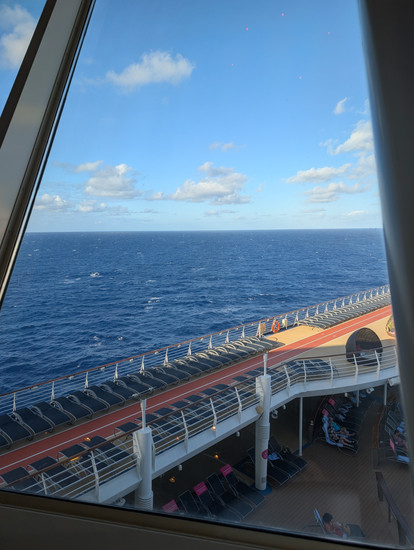Caribbean Cruise – What to Expect on a Cruise Ship and What You Need to Know for Your First Trip?
- Alicja Białogłowska
- Feb 27
- 9 min read
Going on a cruise had never been high on my travel bucket list. I associated it with an all-inclusive resort on the water, a lot of passive entertainment, and limited freedom of movement. However, I decided to try it and see if my assumptions were correct. Was it worth it? What did I like, and what didn't quite meet my expectations? Here's my honest take on the cruise experience.

I decided to find out what a cruise ship experience* is really like. What attractions await on board? What are the pros and cons of this way of traveling? And most importantly, is it a good idea to go with a one-year-old child? I'll cover all of this in this article.
This will be the first entry in a series about our journey. The following articles will focus on the islands we visited (which will be linked below as soon as they are published):
Puerto Plata, Dominican Republic
San Juan, Puerto Rico
Philipsburg, St. Maarten
Roseau, Dominica
Saint John's, Antigua and Barbuda
Basseterre, Saint Kitts and Nevis
Cruising with a 1-year-old – Is It a Good Idea?

A Caribbean cruise seemed like a great idea, especially because of our one-year-old, Artur. However, I realize that a cruise can evoke mixed feelings among parents. On one hand, it’s a convenient way to visit multiple destinations without the hassle of packing and unpacking every few days. On the other hand, there may be concerns about whether life on board will be comfortable for a small child.

Modern cruise ships are often well-equipped for families. Play areas, pools, kids' clubs, and even dedicated entertainment programs keep children occupied while giving parents a chance to relax. However, on our ship, most of the activities were designed for children over the age of three. There was no nursery—only a preschool program starting at three years old—but some newer ships do offer childcare for younger children. Many cruises also provide special menus for toddlers, and family cabins come with extra amenities. The rooms are safe, and cribs are available for the youngest passengers.
For families with small children, the biggest advantage of a cruise is that the ship serves as a floating hotel. There’s no need to pack and unpack every day, search for accommodations, or plan transportation. You simply board the ship, and everything happens automatically—it takes you from place to place, allowing you to focus on enjoying the trip and planning activities on the islands you visit.
Exploring multiple islands in a short time can be challenging when traveling with a child—fatigue, logistics, and different modes of transportation can all add up. A cruise eliminates this problem: each morning, you wake up in a new destination, ready to explore without the hassle of organizing further travel.
What are the downsides?
Cabins on cruise ships are usually smaller than standard hotel rooms, which can be challenging, especially when traveling with a baby and needing space for a stroller or travel crib. Our stroller was foldable and fit easily into the closet, which helped us keep more space available for playing.
Young children may need some time to adjust to a new environment. A different daily rhythm, new surroundings, and unfamiliar stimuli can initially make them fussier or unsettled. It helps to maintain some familiar routines, like nap times (if possible) and bringing favorite toys. Luckily, our time zone adjustment went smoothly in both directions, but that’s not always the case. It required sticking to a structured daily rhythm and making some sacrifices—but in the end, it was worth it.
Not all children handle the movement of a ship well. While modern cruise ships are very stable, rough seas can still cause motion sickness. It’s a good idea to have reliable remedies on hand and consult the onboard doctor if needed.
What Did the Ship and Our Cabin Look Like?
The ship was a true floating city—it had everything you could wish for. Restaurants, a casino, pools, a theater, an ice-skating rink, and even an ice cream stand and Coca-Cola vending machines. There was a climbing wall, a surfing simulator, tennis courts, sports fields, water slides, a spa, and a gym. For shopping lovers, there were stores, art auctions, and jewelry showcases. For those who needed a moment of peace, there was a library, an internet café, and a designated quiet space.

You could play bingo, sudoku, and board games or take part in trivia quizzes with prizes. In the evenings, there were live concerts, themed parties, and various social events—ranging from singles meet-ups to gatherings for veterans and LGBTQ+ evenings.
However, there was no free WiFi on board. You could, of course, purchase internet access, but it came at a hefty price—$28 per day. The internet café had desktop computers available, but they were also paid (which wasn’t surprising, considering the ship was built in 2000).
The selection of food was enormous. On the 11th deck, there was the main buffet, open for breakfast, lunch, and dinner. You could find almost everything there: classic international dishes, vegetarian options, burgers, pasta, salads, bread, desserts, and drinks. The complimentary drink options included water, lemonade, cola, juices, tea, and coffee, while alcohol and bottled water came at an extra charge.
Additionally, on the fifth deck, you could grab coffee, tea, pizza, or small snacks 24/7—also free of charge.
For those who preferred a more intimate dining experience with table service, there was also a three-story restaurant included in the complimentary dining options.

The ship carried 3,200 passengers, with a crew of 1,200 to take care of them. That’s a huge number, yet it never felt crowded—except maybe near the elevators at peak times. The ship was so spacious, and there were so many activities available, that the number of people on board wasn’t really noticeable.
Our Cabin? We chose one of the simplest cabins—an inside room with no window. However, it had a comfortable, large bed, a TV, and a private bathroom. There was also a spacious wardrobe for all our luggage, a desk, and a crib for our little one. The room served its purpose, but next time, we would definitely go for a cabin with a window or a balcony to enjoy the ocean views.
What to Prepare for?
If you're going on a cruise for the first time, here are a few things worth knowing:
Internet & Connectivity - There is no free WiFi on board, and internet access is usually expensive. Be prepared for a digital detox or purchase an internet package before departure if you plan to stay online. However, the package will only work on islands or near the shore—once you're in the open ocean, there’s no signal.
Medications & Essentials - There is a medical center on board, but the prices can be high. It’s a good idea to bring a basic first-aid kit with you.
Your Own Bottle or Flask - Bringing your own water bottle is a smart move. While cups are available in the dining areas, having your own bottle is simply more convenient (and practical). A thermal mug for coffee is also useful, allowing you to take your drink back to your cabin or onto the island.
Wind on the Open Sea - Weather conditions can vary, but be prepared for strong winds. We experienced gusts of over 70 km/h at times, while on other days, there was no wind at all. Having appropriate clothing for different conditions is a must.
Extra Fees - The base price of the cruise is not the final cost. An additional service charge for the crew (called gratuity) is added daily. On our ship, it was $18.50 per person per day, but this amount depends on the cruise line and cabin class.
Themed Nights - The cruise features themed parties and formal dinners requiring elegant attire. We knew about the formal dress code, but we didn’t fully check the details on themed nights—something to keep in mind for next time!
An Ocean View Cabin is a Game Changer - We stayed in an inside cabin without a window. While it’s a budget-friendly option, next time, we’d definitely choose a cabin with a window or a balcony. Having an ocean view truly enhances the experience.
Payments on Board - Cash is not needed on the ship, as all expenses are charged to a card linked to your cabin. At the end of the cruise, you’ll receive a final bill—keeping track of your spending throughout the trip helps avoid unexpected surprises.
What Surprised Us in a Good Way?
Food – before the trip, I had heard that cruise food is often mediocre to encourage guests to pay for specialty dining. However, our experience was completely different! The food was excellent, diverse, always fresh, and available in huge quantities.
Buffet-style breakfast, lunch, and dinner
A three-story restaurant with waiter service
24-hour pizza and snack station
Ice cream and drinks available in multiple locations
Free water, coffee, tea, lemonade, and cola
Paid specialty restaurants for those looking for a more intimate dining experience
Number of Free Activities – I was worried there wouldn’t be much to do without paying extra. But it turned out there were plenty of included attractions!
Pools, jacuzzis, ice-skating rink, theater
Climbing wall, surfing simulator, gym
Trivia games, live concerts, themed discos
Casino, jewelry showcases, art auctions
Kids' activities (for ages 3 and up)
Library, internet café (internet access was paid)
No crowds – Even with over 3,000 passengers on board, it never felt overcrowded. Whether at the pools, restaurants, or theaters, there was always enough space. The organization of embarking and disembarking at ports was also very efficient.
Smooth Boarding and Disembarking – We expected long waits when getting on and off the ship at ports, but everything was incredibly smooth. No endless queues—disembarking and returning to the ship took just a few minutes.
Feeling of Safety – The ship was well-secured, and safety procedures were clearly outlined. The crew was well-trained and prepared for any situation, making us feel at ease throughout the journey.
Ship App - The ship had its own app, and it was a game changer.
Real-time schedule of events
Daily plans, notifications, and alerts
A built-in messenger to contact other passengers without needing a WiFi package
Signed up for an event? You’d get a reminder when it was about to start
Hungry? The app showed which restaurants were currently open
It felt like having Google Maps, Calendar, and Messenger—just for the ship!
What Surprised Us in a Negative Way?
Lack of Attractions for Babies and Toddlers – One major downside was the lack of a daycare or an all-day play area for young children. There were specific hours when toys were available in the teen lounge, but outside of those times, the room sat empty because teenagers weren’t using it. Apparently, newer ships have dedicated play areas for kids aged 6–36 months, a baby pool, and even a nursery, which would have made a big difference.
No Pool Access for Babies in Diapers – I completely understand the hygiene reasons, but given the high number of young kids on board, there could have been at least one designated water play area for them—even a small splash pool (which, again, is available on newer ships).
Short Time in Some Ports -In some destinations, the time spent on land was quite limited. There were instances when the ship departed early in the afternoon, which meant sightseeing had to be rushed. It would have been great to have longer stops, especially in places worth exploring in depth.
No Free Wi-Fi – This was one of the biggest surprises. In today's world, it’s rare to find a place without free internet. While Wi-Fi was available for purchase, the prices were extremely high, and the connection speed was slow. The only alternative was using free Wi-Fi at ports, but that wasn’t always convenient.
Cruise Ship with a Child – Summary
A cruise is undoubtedly a unique experience that combines relaxation, sightseeing, and entertainment in one place. It’s a great option for families, especially since there are plenty of activities on board, food available at any time, and friendly service that allows you to truly unwind – even when traveling with a toddler.
However, it’s worth keeping in mind certain challenges, such as additional costs or limitations for very young children. A cruise is a specific way of traveling – on one hand, it offers great freedom in planning your time, but on the other, it requires adapting to the ship’s schedule.
Would I recommend a cruise to other families? Yes, but with proper preparation. The key is to be aware of the costs, choose the right ship and itinerary, and adjust expectations – this is not a classic land-based trip, but it can be just as fascinating. If you appreciate comfort, a variety of activities, and don’t mind a certain "hotel-like" routine, a cruise might be an excellent choice.
As for me? It felt a bit too much like an "all-inclusive" stay, leaving too little time for exploring the islands. However, I know that for many people, this is actually an advantage. It’s an interesting alternative to traditional travel, especially for those looking for a mix of relaxation and sightseeing. And if, like me, you were skeptical at first – it’s definitely worth trying it for yourself.
In the upcoming articles, I’ll share more about the islands I visited – their attractions, atmosphere, and my impressions. Stay tuned! 🚢✨

*This article is based on my experience aboard the Royal Caribbean Explorer of the Seas. However, it’s important to remember that every cruise ship is different – they can vary in size, cabin standards, dining options, available attractions, and even the overall atmosphere on board. Some ships are more luxurious, while others cater specifically to families with children or adults traveling without kids. Differences also include policies on additional fees, the quality of entertainment and activities, and even the level of service. That’s why choosing the right ship and cruise line plays a crucial role in shaping the entire experience.





















Comments